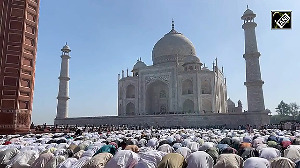Large parts of northern and eastern India remained in the grip of a sweltering heat wave on Tuesday, driving power demands to record highs with warmer-than-usual nights further exacerbating people's distress.

The India meteorological department said heat wave to severe heat wave conditions prevailed in parts of Uttar Pradesh, south Uttarakhand, Himachal Pradesh, Haryana, Chandigarh, Delhi, Punjab and pockets of north Madhya Pradesh, Odisha, Jharkhand, Bihar and the Jammu division.
Maximum temperatures ranged from 44 to 46 degrees Celsius in many parts of Punjab, Haryana, Chandigarh, Delhi, Uttar Pradesh, and some parts of north Madhya Pradesh, south Bihar and north Rajasthan.
The blistering heat has left a large number of people scrambling for water, with storage levels in reservoirs and rivers hitting record lows.
The shortage of water for irrigation is impacting agriculture in some areas.
The power grids are under immense pressure and there has been an increase in incidents of short circuits and fires.
Delhi, which is facing a severe water crisis, recorded a maximum temperature of 44 degrees Celsius over five notches above the normal. The minimum temperature in the city was 33.8 degrees Celsius, at least six notches above what is normal for this time of the year.
The national capital's peak power demand on Tuesday afternoon reached 8,647 MW, the highest ever for the city.
According to officials, cooling load due to the increased use of air conditioners and other cooling appliances amid the relentless heat wave has led to a record rise in power demand.
Hospitals in Delhi-NCR have been seeing an influx of patients with complaints of heat stroke and heat exhaustion as the mercury continued to soar, with doctors advising the elderly and immuno-compromised patients to avoid stepping outdoors.
IMD officials said high minimum temperatures or warm nights are exacerbating the impact of the deadly heat.
High night temperatures are considered dangerous because the body does not get a chance to cool down. Increasing nighttime temperature is more common in cities because of the urban heat island effect, in which metro areas are significantly hotter than their surroundings.
At least 10 places in Uttar Pradesh, Delhi, Punjab and Haryana reached or surpassed 45 degrees Celsius on Tuesday, with Orai in Uttar Pradesh being the warmest place in the country at 46.4 degrees Celsius.
"This is scaring me. The minimum temperature in cities is not going down. People are not getting a chance to recover which means that we are getting more deaths at night than during the daytime, because normally the minimum temperature would fall and you would be able to recover to go back to work the next day, just not getting that," noted environmentalist Sunita Narain told PTI editors in New Delhi.
India is experiencing one of its hottest summers this time. Multiple heat waves have pushed millions in the country to their limits and many states have reported heat-related deaths.
According to IMD, around 40 percent of the country has recorded double the number of heat wave days than it usually does.
In Rajasthan, Sangaria was the hottest place in the state with a maximum temperature of 44.9 degrees Celsius. The night temperature in all cities of the state was two to 7.3 degrees higher than normal.
Rajasthan has hit 50 degrees Celsius twice over the last few weeks, and Delhi has recorded temperatures above 40 degrees Celsius for 36 consecutive days.
The IMD also said heavy to very heavy rainfall is likely to continue over Sub-Himalayan West Bengal, Assam and Meghalaya during the next two days.
According to data compiled by the National Centre for Disease Control, 46 heat-related deaths and over 19,000 cases of suspected heat stroke were reported in the country in May. Officials say this data does not include deaths from many states such as Uttar Pradesh, Bihar, and Delhi, and could just be the tip of the iceberg.
Experts attribute the scorching heat to climate change and the naturally occurring El Niño phenomenon -- which is basically unusual warming of the ocean surface in the central and eastern Pacific Ocean.
While heat waves are common in India during April and May, scientists say climate change has made them more frequent and intense.
Data shows that 12 of the warmest years in India have occurred since 2006, with 2016 experiencing the highest temperatures to date.
The World Weather Attribution Group said similar heatwaves, which once occurred every 30 years, have become about 45 times more likely due to climate change.
Experts say urban regions like Delhi-NCR have become heat chambers due to the loss of green cover and water bodies, and mindless concretization, which causes a heat multiplier effect.
Severe and frequent heat waves have a bigger impact on low-income households, which often have limited capacity to deal with extreme heat due to poor access to water and electricity. Also, the design and construction of informal houses often result in poor ventilation and little shelter from heat.
The heat is testing the endurance of outdoor workers, forcing them to take frequent breaks, which leads to a loss of income.
According to a survey conducted by Greenpeace India and the National Hawker Federation, over 80 percent of the street vendors surveyed in Delhi reported a decline in customers during heatwave days in April and May, and around 50 percent experienced significant income loss.
Governments are ensuring that the less privileged have enough water and electricity. As immediate response measures, water-filled tankers are being sent to places grappling with water shortages. Gas-fired power generation is being increased to avoid power cuts.
As long-term measures, central and state governments are updating their heat action plans, identifying vulnerable communities, and implementing solutions such as cool roofing, improving green cover, and recharging water bodies. Governments are also installing subsidized rooftop solar systems to help households not yet connected to the power grid access electricity
Rajasthan's Ganganagar hottest at 46.2 deg C
Crippling heatwave continues in Rajasthan as Ganganagar recorded the highest maximum temperature in the state at 46.2 degrees Celsius on Tuesday, the meteorological centre in Jaipur said.
While light rain was recorded in parts of eastern Rajasthan in the last 24 hours till 8.30 am today, the weather remained dry in the western region, it said.
During this time, severe heatwave was recorded at some places in Bikaner and Jaipur divisions while some parts of Jaipur, Kota, Jodhpur, Ajmer and Bikaner divisions witnessed warm nights, it said.
The Jaipur Meteorological Centre has issued a warning of heatwave in many areas of the state for the next few days.
Ganganagar was the hottest place in Rajasthan at 46.2 degrees Celsius. The highest rainfall of six millimetres was recorded in Dholpur district's Baseri town.
According to the weather department, maximum temperature, in the next 48 hours, is likely to be recorded between 44 and 47 degrees Celsius in Bikaner, Bharatpur and Jaipur divisions. Heatwaves and hot nights will also prevail in some places.
Strong surface winds are likely to blow at a speed of 30 to 40 kilometres per hour in some parts of the state, the department said.











 © 2025
© 2025